Post by oldgreengrolar on Jan 14, 2023 11:48:46 GMT
Monk Vulture, Cinereous Vulture or Eurasian Black Vulture
Aegypius monachus
Accipitriforme Order – Accipitridae Family
BIOMETRICS :
Length: 98-107 cm ; Wingspan : 250-295 cm ; Weight : 7-12,5 kg
LONGEVITY:
Up to 25 years in wild (39 in captivity)
DESCRIPTION:
Monk Vulture is one of the largest vultures of the Old World. This species is classified as Near Threatened, even in Spain where these wonderful birds are very protected, but always threatened by illegal poisoning and persecution.
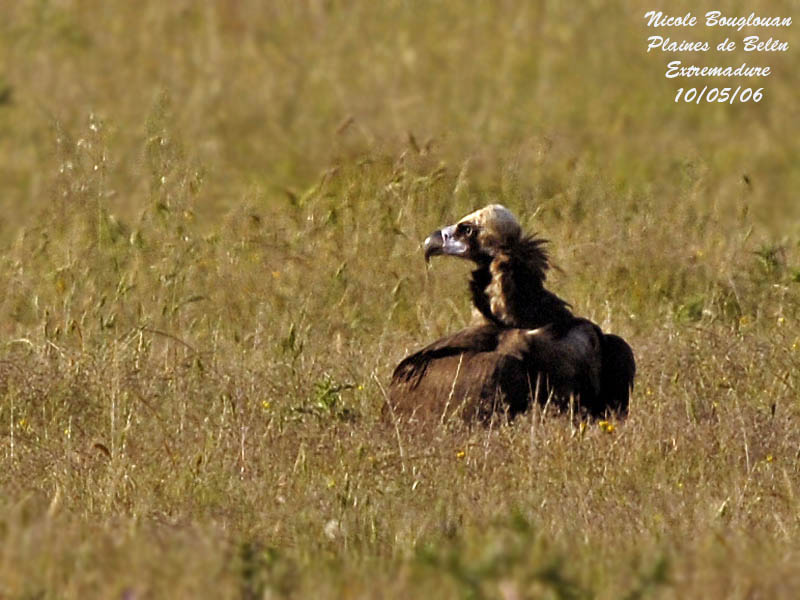
The adult male has almost black plumage, very dark brown overall, with black flight feathers.
The underparts show dark lesser and median coverts. Flight feathers are paler, and the greyish great coverts form a pale band through the underwing.
But this vulture always seems to be very dark. Wings are long and broad, and tail is short and squared.
The head is paler than the body, with bluish-grey bare skin and neck. The head is covered with short pale down. In the oldest birds, the ruff is paler and often fluffed.
The strong, hooked bill shows bluish-grey cere and dark grey to blackish tip. Eyes are dark brown. Legs and talons are bluish-grey.
Both sexes are similar, with female slightly larger than male.
Immature is darker, almost black. On the head, the top is covered with black down.
Juvenile has black head and almost black bill.
Little by little, head and bill will turn paler.
This species needs about five years to get the adult plumage.
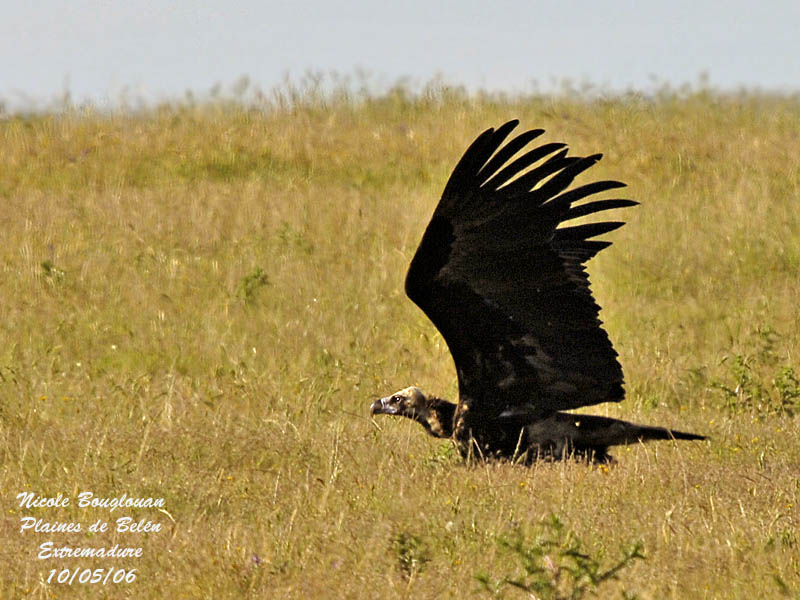
VOICE: SOUNDS BY XENO-CANTO
Monk Vulture is usually silent, but it may utter shrills or meowing when near a carcass or at nest-site or breeding areas.
HABITAT:
Monk Vulture frequents wooded and forested areas in mountains or hills. It can be seen from 300 to 1400 metres of elevation in Spain. In its Asian range, this species lives at higher elevation, between 800 and 3800 metres, even higher, up to 4500 metres in arid and semi-arid grasslands.
It can be seen searching for food over woodlands and open areas such as steppes or upland meadows.
RANGE:
Monk Vulture is resident in most areas from southern Europe to Asia. Its distribution forms a kind of band at this level.
In some parts of this distribution, the species winters southwards.
BEHAVIOUR:
Monk Vulture is often seen flying, soaring in the air with few wing beats.
This vulture feeds on carrion, rarely taking live preys. It feeds mainly at carcasses from medium-sized to large animals.
Monk Vulture is usually the dominant species at carcasses, thanks to its large size and its strong bill which allows it to tears muscles, tendons and skin.
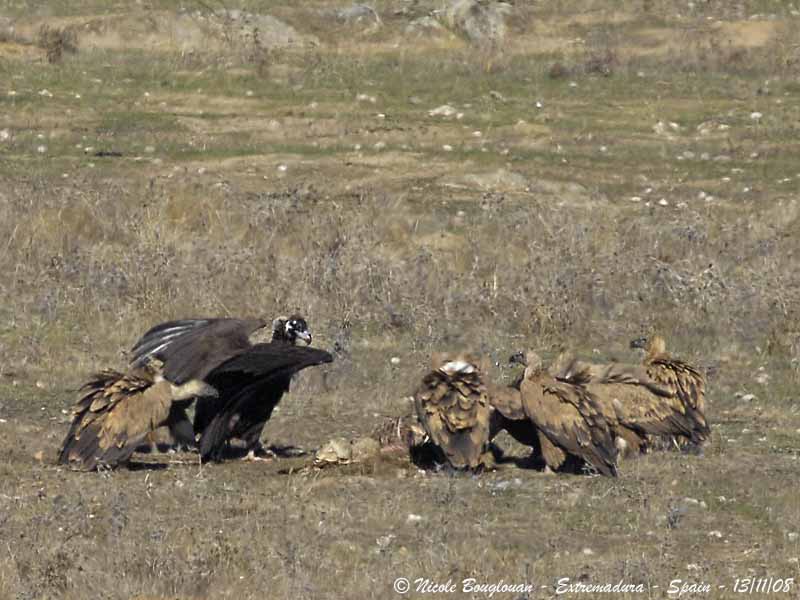
It has more flexible talons than Griffon Vulture that allows it to capture live preys such as injured or sick animals. It may sometimes attack new-born sheep if isolated from its mother. But it feeds primarily on carrion and dead animals.
The Monk Vulture lives in relatively restricted territory where it watches for carcasses by low flight, perching frequently on trees or on the ground. It searches for food in scrubby and wooded areas.
It lives in areas far from human habitations, but near pastures and hunting areas.
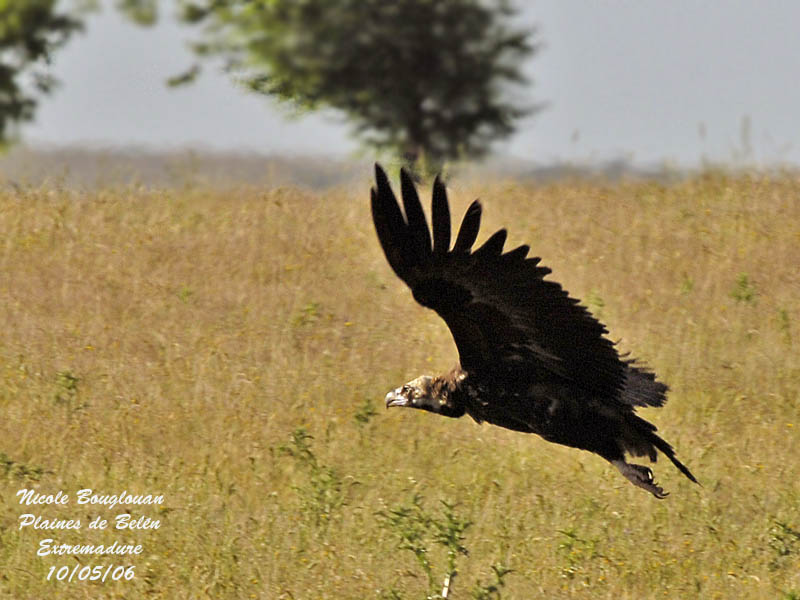
It is often seen with other species such as Griffon Vulture, and usually rarely alone, but rather in pair or small groups. It nests in colonies with nests at about 200 – 400 – 500 to 1000 metres apart.
Monk Vultures gather at roost for the night, outside of breeding season. Juvenile and immature often gather at these roosts.
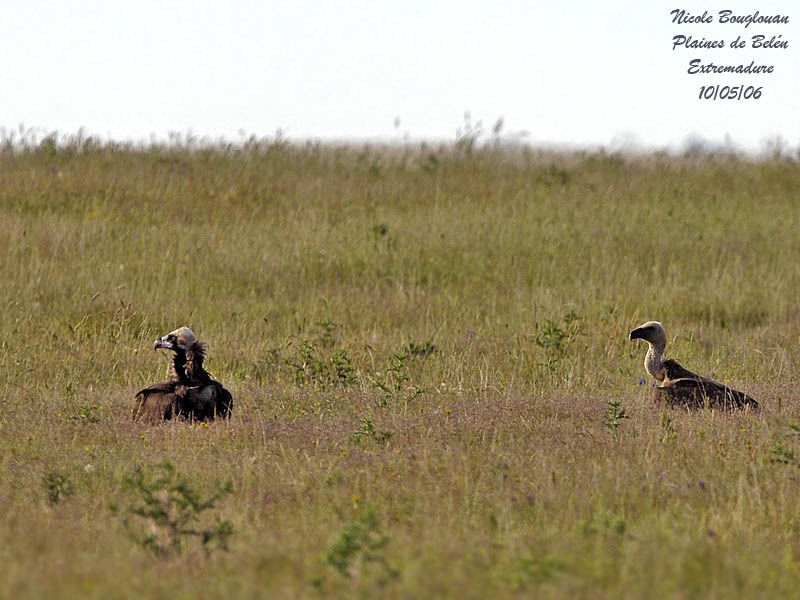
FLIGHT:
Monk Vulture is impressive in flight due to its large size. When it is soaring, it is completely flat with the primaries slightly up-curved.
When it takes off, it performs slow and deep wing beats.

REPRODUCTION:
Breeding season occurs from February to April.
The nest is usually placed high in tree, between 20 and 30 metres above the ground. In Spain, it often nests in cork-oaks, lower, at about 3-4 metres, sometimes 10 above the ground. The nest is at treetop, allowing this large vulture to alight or take off easily.
The nest is very large and reused year after year. Each year, adults add new materials, making some nests really huge. A new nest may size about 95 cm high and 150 cm of diameter, whereas oldest nests may size 140-200 cm high and 180 cm of diameter.
It is made with large sticks of cork-oak and the interior is lined with dried grasses. The nest is maintained all year round by the adults which regularly bring sticks at nest. Materials are collected in the surroundings of the nest-site.
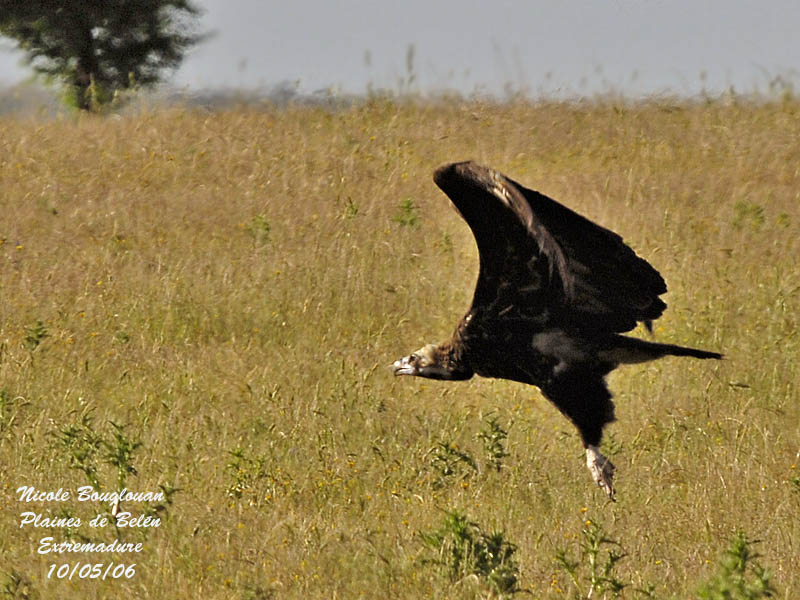
The female lays only one pale grey to white egg in the first half of March. Incubation lasts about 52 to 54 days, by female alone.
The chick is covered with greyish-white down at hatching. It is completely feathered at two months, and it is able to fly at 3-4 months of age.
The young is fed at nest by both parents, by regurgitation into the nest and then, giving pieces of food with the bill. The adults provide shade to the chick with their broad wings. An adult remains at nest with the young, waiting for the mate.
The young birds leave the nest-site and perform dispersion after the reproduction. They often gather at feeding areas, fairly distant from the parental territory.
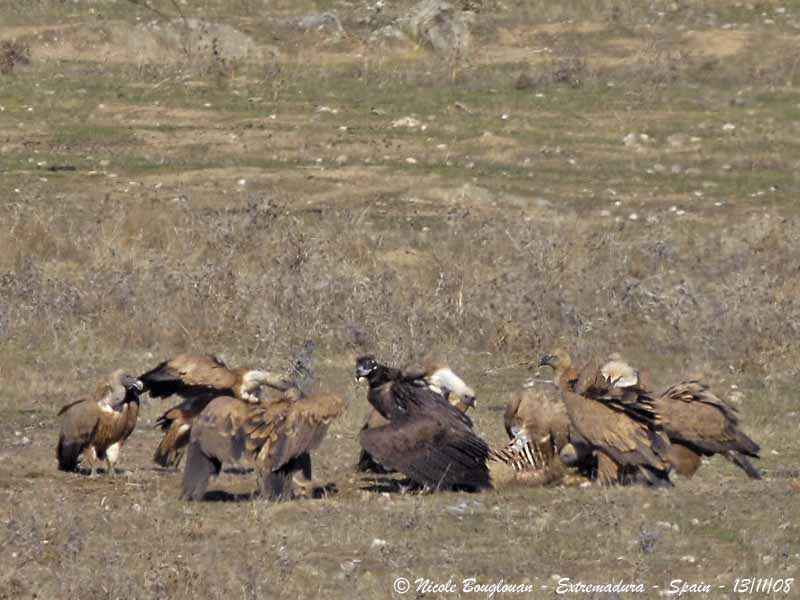
Home
Presentation
Cards
Articles
Trips
Galleries
Links
Last updates
Contact
Legal issues
Monk Vulture, Cinereous Vulture or Eurasian Black Vulture
Aegypius monachus
Accipitriforme Order – Accipitridae Family
BIOMETRICS :
Length: 98-107 cm ; Wingspan : 250-295 cm ; Weight : 7-12,5 kg
LONGEVITY:
Up to 25 years in wild (39 in captivity)
DESCRIPTION:
Monk Vulture is one of the largest vultures of the Old World. This species is classified as Near Threatened, even in Spain where these wonderful birds are very protected, but always threatened by illegal poisoning and persecution.
The adult male has almost black plumage, very dark brown overall, with black flight feathers.
The underparts show dark lesser and median coverts. Flight feathers are paler, and the greyish great coverts form a pale band through the underwing.
But this vulture always seems to be very dark. Wings are long and broad, and tail is short and squared.
The head is paler than the body, with bluish-grey bare skin and neck. The head is covered with short pale down. In the oldest birds, the ruff is paler and often fluffed.
The strong, hooked bill shows bluish-grey cere and dark grey to blackish tip. Eyes are dark brown. Legs and talons are bluish-grey.
Both sexes are similar, with female slightly larger than male.
Immature is darker, almost black. On the head, the top is covered with black down.
Juvenile has black head and almost black bill.
Little by little, head and bill will turn paler.
This species needs about five years to get the adult plumage.
VOICE: SOUNDS BY XENO-CANTO
Monk Vulture is usually silent, but it may utter shrills or meowing when near a carcass or at nest-site or breeding areas.
HABITAT:
Monk Vulture frequents wooded and forested areas in mountains or hills. It can be seen from 300 to 1400 metres of elevation in Spain. In its Asian range, this species lives at higher elevation, between 800 and 3800 metres, even higher, up to 4500 metres in arid and semi-arid grasslands.
It can be seen searching for food over woodlands and open areas such as steppes or upland meadows.
RANGE:
Monk Vulture is resident in most areas from southern Europe to Asia. Its distribution forms a kind of band at this level.
In some parts of this distribution, the species winters southwards.
BEHAVIOUR:
Monk Vulture is often seen flying, soaring in the air with few wing beats.
This vulture feeds on carrion, rarely taking live preys. It feeds mainly at carcasses from medium-sized to large animals.
Monk Vulture is usually the dominant species at carcasses, thanks to its large size and its strong bill which allows it to tears muscles, tendons and skin.
It has more flexible talons than Griffon Vulture that allows it to capture live preys such as injured or sick animals. It may sometimes attack new-born sheep if isolated from its mother. But it feeds primarily on carrion and dead animals.
The Monk Vulture lives in relatively restricted territory where it watches for carcasses by low flight, perching frequently on trees or on the ground. It searches for food in scrubby and wooded areas.
It lives in areas far from human habitations, but near pastures and hunting areas.
It is often seen with other species such as Griffon Vulture, and usually rarely alone, but rather in pair or small groups. It nests in colonies with nests at about 200 – 400 – 500 to 1000 metres apart.
Monk Vultures gather at roost for the night, outside of breeding season. Juvenile and immature often gather at these roosts.
FLIGHT:
Monk Vulture is impressive in flight due to its large size. When it is soaring, it is completely flat with the primaries slightly up-curved.
When it takes off, it performs slow and deep wing beats.
REPRODUCTION:
Breeding season occurs from February to April.
The nest is usually placed high in tree, between 20 and 30 metres above the ground. In Spain, it often nests in cork-oaks, lower, at about 3-4 metres, sometimes 10 above the ground. The nest is at treetop, allowing this large vulture to alight or take off easily.
The nest is very large and reused year after year. Each year, adults add new materials, making some nests really huge. A new nest may size about 95 cm high and 150 cm of diameter, whereas oldest nests may size 140-200 cm high and 180 cm of diameter.
It is made with large sticks of cork-oak and the interior is lined with dried grasses. The nest is maintained all year round by the adults which regularly bring sticks at nest. Materials are collected in the surroundings of the nest-site.
The female lays only one pale grey to white egg in the first half of March. Incubation lasts about 52 to 54 days, by female alone.
The chick is covered with greyish-white down at hatching. It is completely feathered at two months, and it is able to fly at 3-4 months of age.
The young is fed at nest by both parents, by regurgitation into the nest and then, giving pieces of food with the bill. The adults provide shade to the chick with their broad wings. An adult remains at nest with the young, waiting for the mate.
The young birds leave the nest-site and perform dispersion after the reproduction. They often gather at feeding areas, fairly distant from the parental territory.
DIET:
Monk Vulture feeds mainly on dead animals and carrion. According to the range, it may catch some lizards and insects, but it feeds mainly on dead rabbits and deers, and usually small animals. When feeding at carcasses, it prefers the hard parts such as skin, tendons and cartilages.

PROTECTION / THREATS / STATUS:
Monk Vulture is classified as Threatened at world level. This species suffers disturbances at nest, habitat loss, illegal poisoning, persecutions and lack of food. In China, they are trapped and killed for feather trade.
The most part of the population is in Spain where about 1500 pairs are living. Important protection measures are already active, and others in progress, in order to protect this species and its environment.
Fr: Vautour moine
All : Moenchsgeier,
Esp : Buitre Negro
Ital : Avvoltoio monaco
Nd : Monniksgier
Photographs and text by Nicole Bouglouan
Sources:
HANDBOOK OF THE BIRDS OF THE WORLD Vol 2 by Josep del Hoyo-Andrew Elliot-Jordi Sargatal - Lynx Edicions - ISBN: 8487334156
GUIDE DES RAPACES DIURNES – Europe, Afrique du Nord et Moyen-Orient de Benny Génsbol – Delachaux et Niestlé – ISBN : 2603013270
Avibase (Lepage Denis)
Pájaros de España (JL Beamonte)
Home page
Page birds of prey
Other article: The Old World Vultures
Summary cards
www.oiseaux-birds.com/card-monk-vulture.html
Aegypius monachus
Accipitriforme Order – Accipitridae Family
BIOMETRICS :
Length: 98-107 cm ; Wingspan : 250-295 cm ; Weight : 7-12,5 kg
LONGEVITY:
Up to 25 years in wild (39 in captivity)
DESCRIPTION:
Monk Vulture is one of the largest vultures of the Old World. This species is classified as Near Threatened, even in Spain where these wonderful birds are very protected, but always threatened by illegal poisoning and persecution.

The adult male has almost black plumage, very dark brown overall, with black flight feathers.
The underparts show dark lesser and median coverts. Flight feathers are paler, and the greyish great coverts form a pale band through the underwing.
But this vulture always seems to be very dark. Wings are long and broad, and tail is short and squared.
The head is paler than the body, with bluish-grey bare skin and neck. The head is covered with short pale down. In the oldest birds, the ruff is paler and often fluffed.
The strong, hooked bill shows bluish-grey cere and dark grey to blackish tip. Eyes are dark brown. Legs and talons are bluish-grey.
Both sexes are similar, with female slightly larger than male.
Immature is darker, almost black. On the head, the top is covered with black down.
Juvenile has black head and almost black bill.
Little by little, head and bill will turn paler.
This species needs about five years to get the adult plumage.

VOICE: SOUNDS BY XENO-CANTO
Monk Vulture is usually silent, but it may utter shrills or meowing when near a carcass or at nest-site or breeding areas.
HABITAT:
Monk Vulture frequents wooded and forested areas in mountains or hills. It can be seen from 300 to 1400 metres of elevation in Spain. In its Asian range, this species lives at higher elevation, between 800 and 3800 metres, even higher, up to 4500 metres in arid and semi-arid grasslands.
It can be seen searching for food over woodlands and open areas such as steppes or upland meadows.
RANGE:
Monk Vulture is resident in most areas from southern Europe to Asia. Its distribution forms a kind of band at this level.
In some parts of this distribution, the species winters southwards.
BEHAVIOUR:
Monk Vulture is often seen flying, soaring in the air with few wing beats.
This vulture feeds on carrion, rarely taking live preys. It feeds mainly at carcasses from medium-sized to large animals.
Monk Vulture is usually the dominant species at carcasses, thanks to its large size and its strong bill which allows it to tears muscles, tendons and skin.

It has more flexible talons than Griffon Vulture that allows it to capture live preys such as injured or sick animals. It may sometimes attack new-born sheep if isolated from its mother. But it feeds primarily on carrion and dead animals.
The Monk Vulture lives in relatively restricted territory where it watches for carcasses by low flight, perching frequently on trees or on the ground. It searches for food in scrubby and wooded areas.
It lives in areas far from human habitations, but near pastures and hunting areas.

It is often seen with other species such as Griffon Vulture, and usually rarely alone, but rather in pair or small groups. It nests in colonies with nests at about 200 – 400 – 500 to 1000 metres apart.
Monk Vultures gather at roost for the night, outside of breeding season. Juvenile and immature often gather at these roosts.

FLIGHT:
Monk Vulture is impressive in flight due to its large size. When it is soaring, it is completely flat with the primaries slightly up-curved.
When it takes off, it performs slow and deep wing beats.

REPRODUCTION:
Breeding season occurs from February to April.
The nest is usually placed high in tree, between 20 and 30 metres above the ground. In Spain, it often nests in cork-oaks, lower, at about 3-4 metres, sometimes 10 above the ground. The nest is at treetop, allowing this large vulture to alight or take off easily.
The nest is very large and reused year after year. Each year, adults add new materials, making some nests really huge. A new nest may size about 95 cm high and 150 cm of diameter, whereas oldest nests may size 140-200 cm high and 180 cm of diameter.
It is made with large sticks of cork-oak and the interior is lined with dried grasses. The nest is maintained all year round by the adults which regularly bring sticks at nest. Materials are collected in the surroundings of the nest-site.

The female lays only one pale grey to white egg in the first half of March. Incubation lasts about 52 to 54 days, by female alone.
The chick is covered with greyish-white down at hatching. It is completely feathered at two months, and it is able to fly at 3-4 months of age.
The young is fed at nest by both parents, by regurgitation into the nest and then, giving pieces of food with the bill. The adults provide shade to the chick with their broad wings. An adult remains at nest with the young, waiting for the mate.
The young birds leave the nest-site and perform dispersion after the reproduction. They often gather at feeding areas, fairly distant from the parental territory.

Home
Presentation
Cards
Articles
Trips
Galleries
Links
Last updates
Contact
Legal issues
Monk Vulture, Cinereous Vulture or Eurasian Black Vulture
Aegypius monachus
Accipitriforme Order – Accipitridae Family
BIOMETRICS :
Length: 98-107 cm ; Wingspan : 250-295 cm ; Weight : 7-12,5 kg
LONGEVITY:
Up to 25 years in wild (39 in captivity)
DESCRIPTION:
Monk Vulture is one of the largest vultures of the Old World. This species is classified as Near Threatened, even in Spain where these wonderful birds are very protected, but always threatened by illegal poisoning and persecution.
The adult male has almost black plumage, very dark brown overall, with black flight feathers.
The underparts show dark lesser and median coverts. Flight feathers are paler, and the greyish great coverts form a pale band through the underwing.
But this vulture always seems to be very dark. Wings are long and broad, and tail is short and squared.
The head is paler than the body, with bluish-grey bare skin and neck. The head is covered with short pale down. In the oldest birds, the ruff is paler and often fluffed.
The strong, hooked bill shows bluish-grey cere and dark grey to blackish tip. Eyes are dark brown. Legs and talons are bluish-grey.
Both sexes are similar, with female slightly larger than male.
Immature is darker, almost black. On the head, the top is covered with black down.
Juvenile has black head and almost black bill.
Little by little, head and bill will turn paler.
This species needs about five years to get the adult plumage.
VOICE: SOUNDS BY XENO-CANTO
Monk Vulture is usually silent, but it may utter shrills or meowing when near a carcass or at nest-site or breeding areas.
HABITAT:
Monk Vulture frequents wooded and forested areas in mountains or hills. It can be seen from 300 to 1400 metres of elevation in Spain. In its Asian range, this species lives at higher elevation, between 800 and 3800 metres, even higher, up to 4500 metres in arid and semi-arid grasslands.
It can be seen searching for food over woodlands and open areas such as steppes or upland meadows.
RANGE:
Monk Vulture is resident in most areas from southern Europe to Asia. Its distribution forms a kind of band at this level.
In some parts of this distribution, the species winters southwards.
BEHAVIOUR:
Monk Vulture is often seen flying, soaring in the air with few wing beats.
This vulture feeds on carrion, rarely taking live preys. It feeds mainly at carcasses from medium-sized to large animals.
Monk Vulture is usually the dominant species at carcasses, thanks to its large size and its strong bill which allows it to tears muscles, tendons and skin.
It has more flexible talons than Griffon Vulture that allows it to capture live preys such as injured or sick animals. It may sometimes attack new-born sheep if isolated from its mother. But it feeds primarily on carrion and dead animals.
The Monk Vulture lives in relatively restricted territory where it watches for carcasses by low flight, perching frequently on trees or on the ground. It searches for food in scrubby and wooded areas.
It lives in areas far from human habitations, but near pastures and hunting areas.
It is often seen with other species such as Griffon Vulture, and usually rarely alone, but rather in pair or small groups. It nests in colonies with nests at about 200 – 400 – 500 to 1000 metres apart.
Monk Vultures gather at roost for the night, outside of breeding season. Juvenile and immature often gather at these roosts.
FLIGHT:
Monk Vulture is impressive in flight due to its large size. When it is soaring, it is completely flat with the primaries slightly up-curved.
When it takes off, it performs slow and deep wing beats.
REPRODUCTION:
Breeding season occurs from February to April.
The nest is usually placed high in tree, between 20 and 30 metres above the ground. In Spain, it often nests in cork-oaks, lower, at about 3-4 metres, sometimes 10 above the ground. The nest is at treetop, allowing this large vulture to alight or take off easily.
The nest is very large and reused year after year. Each year, adults add new materials, making some nests really huge. A new nest may size about 95 cm high and 150 cm of diameter, whereas oldest nests may size 140-200 cm high and 180 cm of diameter.
It is made with large sticks of cork-oak and the interior is lined with dried grasses. The nest is maintained all year round by the adults which regularly bring sticks at nest. Materials are collected in the surroundings of the nest-site.
The female lays only one pale grey to white egg in the first half of March. Incubation lasts about 52 to 54 days, by female alone.
The chick is covered with greyish-white down at hatching. It is completely feathered at two months, and it is able to fly at 3-4 months of age.
The young is fed at nest by both parents, by regurgitation into the nest and then, giving pieces of food with the bill. The adults provide shade to the chick with their broad wings. An adult remains at nest with the young, waiting for the mate.
The young birds leave the nest-site and perform dispersion after the reproduction. They often gather at feeding areas, fairly distant from the parental territory.
DIET:
Monk Vulture feeds mainly on dead animals and carrion. According to the range, it may catch some lizards and insects, but it feeds mainly on dead rabbits and deers, and usually small animals. When feeding at carcasses, it prefers the hard parts such as skin, tendons and cartilages.

PROTECTION / THREATS / STATUS:
Monk Vulture is classified as Threatened at world level. This species suffers disturbances at nest, habitat loss, illegal poisoning, persecutions and lack of food. In China, they are trapped and killed for feather trade.
The most part of the population is in Spain where about 1500 pairs are living. Important protection measures are already active, and others in progress, in order to protect this species and its environment.
Fr: Vautour moine
All : Moenchsgeier,
Esp : Buitre Negro
Ital : Avvoltoio monaco
Nd : Monniksgier
Photographs and text by Nicole Bouglouan
Sources:
HANDBOOK OF THE BIRDS OF THE WORLD Vol 2 by Josep del Hoyo-Andrew Elliot-Jordi Sargatal - Lynx Edicions - ISBN: 8487334156
GUIDE DES RAPACES DIURNES – Europe, Afrique du Nord et Moyen-Orient de Benny Génsbol – Delachaux et Niestlé – ISBN : 2603013270
Avibase (Lepage Denis)
Pájaros de España (JL Beamonte)
Home page
Page birds of prey
Other article: The Old World Vultures
Summary cards
www.oiseaux-birds.com/card-monk-vulture.html
